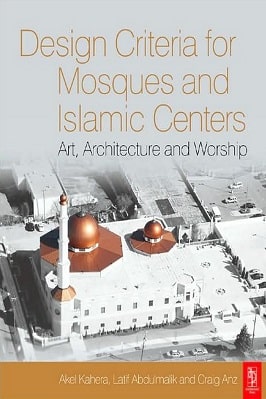
| Design Criteria For Mosques And Islamic Centers |
| Latif Abdumalik |
| 95 |
| |
| PDF Direct Download Link |
| Click for Hard Copy from Amazon |
Design Criteria for Mosques and Islamic Centers
Art, Architecture and Worship by Ake Kahera, Latif Abdumalik and Craig Anz
DESIGN CRITERIA FOR MOSQUES AND ISLAMIC CENTERS
Book Preface
The core of this book deals with several different levels of architectural analysis related to the formation of the urban mosque in Europe and America over the last three or more decades. In this connection, two primary sets of documents are critiqued and dis- cussed.
First, in Chapter 1 our goal is to understand the changing multitude and modes of esthetics, in relation to religious observance or practice, which can become an important educational tool for designers and architects.
The acquisition of places of worship has always played a crucial role in the principle of religious freedom in Europe and America.
Likewise, many religious groups, once settled in a new environment, have always established a place of worship; over the last few decades these places have become symbolically laden arenas with respect to design.
We must keep in mind that in an unfamiliar environment nothing is more meaningful than a familiar image, because it gives expressive meaning to one’s belief and gives identity to a group that for a large part represents a Diaspora community.
By invoking al-Jurjani’s theory, we can understand expressive meaning in architectural language and syntax by following two methods: the first conceives of language as mere words isolated from a context while the second conceives of it as context only.
These two approaches have their parallels in the esthetics of the urban mosque.
One approach views fragments of esthetic meaning as precedent handed down through history, independent of meaning or time.
Another quotes the formal elements devoid of any meaning. But the picture is more complex; besides communal worship there exists a ghostly residue of emotional and cultural feeling attached to the image of the edifice that causes a most intractable design problem.
Towards this end we pro- vide an evaluation of iconic and non-iconic buildings that suggest hybridity, differentiation, integration, and transcendence.
Second, in Chapters 2–4 a wide range of drawings, plans, sections, and elevations are studied; the analysis of these documents sheds light on the ideas conceived by the architect for the edifice as well as the external working of the site and the building plan.
This type of evaluation helps us to also understand to what extent the physical space of the urban mosque exercises control over land use and public space; at the least the evaluation serves as a planning apparatus within the realm of design.
The same apparatus can simultaneously help the designer to carefully experiment at multiple levels of engagement with a building plan since no established design standards exist for a mosque.
Our approach is legitimized by the fact that the word masjid (mosque; pl. masa- jid) literally and quite simply means ‘a place of prostration’, with no a priori style or form dictating it beyond its basic use;
as such the spatial characteristics of the mosque, unlike the church or the synagogue, are intrinsically defined by the act of prostration.
This is especially so because the act of worship (ibadah) is not rigidly tied to a particular place, space or form (covered or uncovered) but rather to a prescribed time. Associated with the place of prostration is the qiblah (the ontological axis) with which a worship- per or an edifice is oriented towards Makkah (Mecca).
Mosques everywhere in the world adhere to this ontological rule; it is an exoteric expression of belief, which must be adhered to. The qiblah is universally recognized by its mihrab, which signifies the point where the imam stands facing Makkah, to lead the faithful in prayer.
It may be a simple demarcated space on the ground or a structural element in an edifice, as a rule that governs worship and the construction of an edifice; the community (ummah) decidedly understands the qiblah.
Owing to the importance of the above esthetic principles and the role they play in the design of a contemporary edifice, in our view the masjid is a system of temporal spatial coordinates;
it carries no preconceived order with the exception of the required physical qiblah orientation of the congregational prayer space (musalla) towards Makkah, and except for the cultural over- lays that quite often may seem to overrule the potential for design.
As an example, when it comes to direct endorsement of women’s right to full participation in the space of the mosque, Claude Lévi-Strauss’s notion, ‘reversible space and linear time’,
To read more about the Design Criteria For Mosques And Islamic Centers book Click the download button below to get it for free
or
Report broken link
Support this Website
for websites